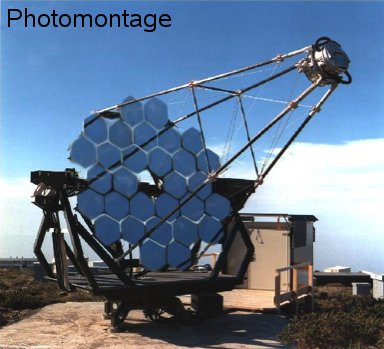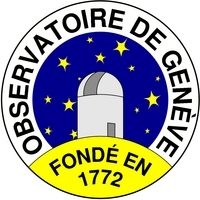
| INTEGRALPlanckGaiaPOLARCHEOPSEuclidATHENA |
| HEAVENSFACTCTALOFTSPICAJEM-EUSOXIPEeXTPTheseus |
| XRISMMAGBOUNDSMARTNet |
| ISDCCDCI |
| Cherenkov Telescope Array |
The FACT Project
 In 2010, the First G-APD Cherenkov Telescope (FACT)
is assembled on the Canary Island of La Palma. This telescope consists of a new
technology camera mounted at the focus of one of the former HEGRA telescopes.
The core of the FACT project is a camera using pixels made of Geiger-mode
avalanche photodiods (G-APDs). The first shower images were successfully
recorded in Zürich (Anderhub et al.
2009) with a 36 pixels prototype G-APD camera. Compared to the currently
used photomultiplier tubes (PMTs), G-APDs need a much lower operation voltage,
are more robust and have a higher photon detection efficiency. Consequently,
these devices are promising for an Imaging Atmospheric Cherenkov Telescope
(IACT) to improve the sensitivity of the instrument compared to the currently
used PMTs. The FACT project will test the feasibility of using G-APD pixels in
Cherenkov astronomy. Also the aim for robotic operation of the telescope will
provide valuable experiences for the CTA project.
In 2010, the First G-APD Cherenkov Telescope (FACT)
is assembled on the Canary Island of La Palma. This telescope consists of a new
technology camera mounted at the focus of one of the former HEGRA telescopes.
The core of the FACT project is a camera using pixels made of Geiger-mode
avalanche photodiods (G-APDs). The first shower images were successfully
recorded in Zürich (Anderhub et al.
2009) with a 36 pixels prototype G-APD camera. Compared to the currently
used photomultiplier tubes (PMTs), G-APDs need a much lower operation voltage,
are more robust and have a higher photon detection efficiency. Consequently,
these devices are promising for an Imaging Atmospheric Cherenkov Telescope
(IACT) to improve the sensitivity of the instrument compared to the currently
used PMTs. The FACT project will test the feasibility of using G-APD pixels in
Cherenkov astronomy. Also the aim for robotic operation of the telescope will
provide valuable experiences for the CTA project.
Scientific Program
Being situated on the Northern hemisphere, a natural target for FACT is the extragalactic sky. Thanks to the technical upgrades and improvements, its sensitivity is improved compared to the original HEGRA telescope. The aim of the project is longterm monitoring of bright active galactic nuclei (AGN) to
- study the statistics of flares and their physical origin
- search for orbital modulation of the blazar emission due to supermassive black hole binaries
- correlate the data with corresponding data from the neutrino observatory IceCube to search for evidence of hadronic emission processes
The FACT Collaboration
The FACT project is a joint effort of Switzerland and Germany with contributions from the following institutes: ETH Zürich, TU Dortmund, ISDC, EPFL and Universität Würzburg.
ISDC Contribution
The FACT data will become public and have important impact on future multi-wavelength studies of AGN. With its experience from various other missions, ISDC will provide the access to the data to the scientific user community. Therefor the following tasks are important:
- sensitivity curve
- automatic scheduling
- organization of data flow, storage and transfer
- data quality assurance
- automatic production and processing of simulated data
- automatic processing and analysis of data
- data access for external users: provide data and results to the scientific community








